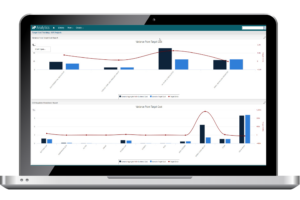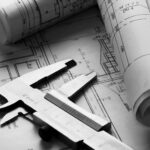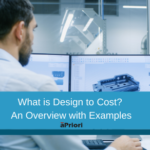
Key Takeaways:
- Hidden product manufacturing cost drivers aren’t always obvious
- aPriori can identify them, optimizing product development, profitability, and time to market
The Full Article:
There are many variables that affect manufacturability, time to market, and profitability. And some are more obvious to identify than others. Although hidden product manufacturing cost drivers usually reside within product development, some arise from external, hard-to-anticipate factors like inflation and geopolitical disruptions. Learn how to identify and address the top five “hidden” product manufacturing cost drivers.
1) Design Hidden Cost Driver
Despite the fact that a product design accounts for 80% of its total cost, design engineers traditionally don’t prioritize cost. Typically, cost engineers review designs for financial feasibility, and require design engineers to refine their 3D CAD models to meet cost targets. It can lead to time-consuming design iterations and late-stage engineering change orders (ECOs), increasing cost drivers.
Solution
Early design stage cost breakouts can be elusive because product engineers don’t have visibility into the financial impact of their decisions – including material selection, design tolerances, and manufacturing processes. And they can be difficult to isolate, measure, and model for cost analysis. aPriori removes the guesswork. Using Design to Cost (DTC), product development teams receive a comprehensive analysis of design and manufacturability selections and cost. Materials, production processes, and cost targets can be optimized in the most critical stage – design. For instance, the analysis may reveal an aesthetic yet costly material, or manufacturability may require longer, more expensive cycle times.
Manufacturing insights provide suggestions for lowering costs without compromising product quality. Potential design and production issues are prevented early in product development, decreasing costly ECOs. aP Generate can analyze each new design iteration automatically when checked into your product lifecycle management (PLM) system. Manufacturers can leverage the digital product, process, and factory twins, which combined, create the digital thread. It unlocks accurate, highly detailed product development cost insights. There is less design iteration, material waste, and energy usage, saving time, money, and resources.
Learn how CNH uncovered hidden product cost drivers with aPriori.
2) Materials Hidden Cost Driver
KPMG revealed that 71% of global companies highlight raw material costs – including material type, utilization, and standard and non-standard stock size – as their main supply chain threat in 2023. Without design insights, some raw materials and their associated costs could be missed.
Solution
DTC automates cost analysis, identifying and optimizing raw materials and supply chain savings. aPriori generates a breakdown of a part’s material cost proportion. Semiconductor chips have been in short supply for several years. A chip deficit could create design for manufacturability and assembly (DFMA) issues. Manufacturing insights offer more cost-effective material alternatives.
The digital thread ensures product development team members are kept apprised of material, manufacturability, or cost issues. Shortages or cost-prohibitive materials can be addressed proactively. Design can work with sourcing and cost engineers to explore available or more affordable materials. Production can monitor material selection’s influence on manufacturability.
Let’s look at an example. By leveraging manufacturing insights to analyze costs, an engineer might find that material utilization was only 11% (meaning nearly 9 lbs. out of every 10 lbs. of raw material would be wasted). Diving deeper into the manufacturing insights, it might be revealed that machining from roughing operations, not the actual finishing of the part, was responsible for most of the part’s cost. As a result, the engineer recognized that working towards a near-net shape for the part was driving up costs, both in materials and production. This example underscores the critical feedback from manufacturing insights in identifying and being able to mitigate potential cost drivers.
See how material type and volume can affect your costs.
3) Supply Chain Hidden Cost Driver
Reuters noted that supply chain disruptions led to an average of $82 million in annual losses per company in 2022. Product manufacturing cost drivers can hide within the supply chain, especially in more complex ones. Market fluctuations, including exchange rates and inflation, also influence hidden product manufacturing cost drivers.
Solution
A real-time, fact-based tool that allows manufacturers to proactively react to market fluctuations is essential. aPriori’s Regional Data Libraries (RDLs) help manufacturers uncover supply chain costs across 87 global regions. They can analyze the best suppliers and supply chain routes, reducing disruptions and costs. Updated quarterly, manufacturers receive current material, labor, and machine data cost analysis from these regions. A cost insights solution like aPriori empowers supplier negotiations with fact-based analysis. It fosters faster, better decision-making regarding how to prioritize cost drivers.
The more detailed, accurate, and consistent supplier data is throughout product development, the clearer the consensus for decision-making. Manufacturers also will be better positioned to act quickly and decisively. Supplier relations and negotiations improve, and total manufacturing costs are better aligned, ensuring profitability.
Explore how Regional Data Libraries can uncover hidden product cost drivers.
4) Labor Hidden Cost Driver
A study found a projected 2.1 million unfilled manufacturing jobs by 2030 potentially could create a $1 trillion loss in that year alone. Skilled worker deficits, direct labor hours, and manufacturing overhead cost drivers, including cycle time to produce a part, machinery, and secondary processes, further complicate full cost estimation foresight.
Solution
Adopting digital transformation removes many labor-related hidden product manufacturing cost drivers including surpluses. Technical, experienced workers can focus on more complex projects, rather than rudimentary or repetitive assembly line tasks. More automation increases productivity, boosting profits.
Real-time cloud collaboration reduces turnover and pandemic-related downtimes. Technology-focused jobs attract and retain employees due to upskilling, better working conditions, and higher engagement and satisfaction. PLM tools often result in an average increase of 10% in production output, 11% in factory capacity utilization, and 12% in labor productivity. Better manufacturing processes streamline the workforce, leading to more cost-effective decision-making.
Listen to Chris Platz explain how Woodward closed the labor gap.
5) Information Siloes Hidden Cost Driver
According to Baker Tilly, U.S. businesses lose up to $1.8 billion each year in wasted productivity due to obsolete technology.
Solution
The Need for Speed: The State of Manufacturing Procurement report underscores a desire for improved manufacturer-supplier collaboration. Seventy percent of OEMs surveyed cited data standardization as a most pressing issue, with 68% concurring better connection between manufacturer and supplier data systems is needed. Better supplier collaboration can help reduce costs by as much as 40%.
aPriori enables cloud-based collaboration, streamlining product lifecycle workflows. aP Analytics loops in team members, sharing the same highly accurate, detailed data from a centralized reporting dashboard. Consequently, DFM, supply chain management, and time to market are optimized. Every aspect of PLM is accounted for – from materials and labor to overhead costs. All can be calculated quickly, resulting in highly accurate cost projections and more cohesive decision-making.
Discover how one professional went from a non-believer to a manufacturing collaboration convert.
You Can Have Your Cost Cake and Eat It Too
With an end-to-end view of design through production, manufacturers can discover the hidden product manufacturing cost drivers that impact profitability. Finding and mitigating them can transform operations and the bottom line.
Even better, they can maximize all operational aspects including product development, supply chain management, their workforce, and knowledge sharing and management – all while reducing less visible costs and without sacrificing product quality.
Reduce Costs, Boost Profitability, Get to Market Faster
Build A Costing Team To Meet Today's Manufacturing Challenges






